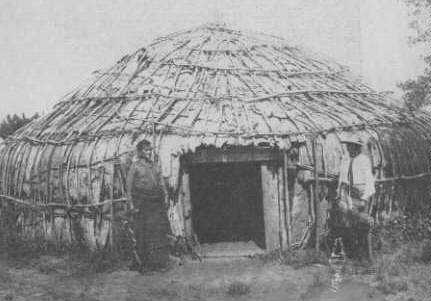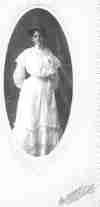|
Prior to 1638, John Prettyman Sr. left England and moved to St. Marys,
Maryland. In 1643, he moved to the Eastern Shore of Virginia and died there in
1688.
Two hundred and twenty years and nine generations later, William Seldon
Prettyman was born to Henry Robert Prettyman and his wife Sarah Pauline Anderson
on November 12, 1858 in Princess Anne County, Maryland. It has been said that
John, at the age of sixteen, and William, at the age of fourteen, left home and
were on their own for the rest of their lives.
Prettyman first married when he was eighteen, his wife, Letticia (surname
unknown), was older. They lived together for a while, then they decided to
separate by mutual consent. Their two daughters went to live with his wife's
family and she obtained a divorce. Later, Prettyman would marry Mary Emma Lamb
in Kansas, and from this union three children were born: Raymond Thomas, Donald
Harry, and Ross William. Daughters by his first wife, Letticia, were named Marta
and Jean.
 After the
separation, William S. Prettyman left Maryland and went out West winding up in
Kansas where in 1879-80 he arrived in Arkansas City, Kansas. It was here that he
learned the photography profession. It was also here, that he learned the
objectives of the Boomer/Sooners(1). That knowledge, fueled by the sense that
history was in the making, created the urge to go into Indian Territory, into
what is now Oklahoma, to photograph for posterity the tribesmen, their style of
life, and their living conditions. The picture on the left was taken prior to
1893. After the
separation, William S. Prettyman left Maryland and went out West winding up in
Kansas where in 1879-80 he arrived in Arkansas City, Kansas. It was here that he
learned the photography profession. It was also here, that he learned the
objectives of the Boomer/Sooners(1). That knowledge, fueled by the sense that
history was in the making, created the urge to go into Indian Territory, into
what is now Oklahoma, to photograph for posterity the tribesmen, their style of
life, and their living conditions. The picture on the left was taken prior to
1893.
R. E. Cunningham states in his book, "Indian Territory":
"This exciting wilderness was too much for the young photographer,
William S. Prettyman of Arkansas City Kansas, who, with wagon and oxen or
mules to transport himself and his photographic equipment, went among the
tribesmen. He had normal curiosity and something more, for like Huffman in
Montana and Jackson in the Rockies, he sensed history in the making and was
determined to record it. Between 1880 and 1909 he made some ten thousand
plates, mostly on glass, of Indians, early white ranchers, the pressing land
seekers, the land rushes, settlement itself, and the coming of comparative
affluence. No one who sees pictures of a land rush can fail to share the
intense excitement of eager settlers, nor fail to detect the hostility in the
Indian woman eyes as sod houses rose nearby on the last American frontier"
In 1893 William S. Prettyman left his studio in Arkansas City, Kansas. He was
ready to make the Cherokee Outlet run in 1893 and take for himself some of the
rich farmland. William S. Prettyman participated in the Cherokee Outlet opening
on September 16, 1893. His special knowledge of the territory, as a result of
his many ventures into the Tribal Territories to take photographs of the
Tribesmen and their life style and of the Oklahoma Territory Land run in
1889(2), and had several locations in mind. It has been said that during the
race his horse stumbled into a Badger hole which broke one stirrup and threw him
from the horse. Cowboy friends "picketed" his horse and he was able to continue
the race for land.
Prettyman and his partner, Charles Hunt, each staked claims of 160 acres four
miles south of Blackwell. The distance from the starting line to where Prettyman
staked his claim was about 20 miles, over prairie land, and they probably
covered that distance in a little over one hour.
It has been estimated that there were in excess of 100,000 land hungry
settlers who participated in the race for the 50,000 claims. Prettyman succeeded
in keeping other settlers and "claim jumpers" from his claim, which he occupied
for one year, then sold to a Dr. Padon in Blackwell, for whom one of the streets
in Blackwell was named.
 In Blackwell, Mr.
Prettyman, had constructed, the first brick building in the town and occupied
the upper floor for his photography gallery, which was one of the finest in the
Oklahoma Territory. His studio is said to have been located in the 100 block of
South main street. The picture on the left was taken in 1897 at the Prettyman
Studio. In Blackwell, Mr.
Prettyman, had constructed, the first brick building in the town and occupied
the upper floor for his photography gallery, which was one of the finest in the
Oklahoma Territory. His studio is said to have been located in the 100 block of
South main street. The picture on the left was taken in 1897 at the Prettyman
Studio.
Mr. Prettyman was quite active in the early development of Blackwell and
served two terms as Blackwell's Mayor. He served his first term as Mayor of
Blackwell from April 5, 1901 to April 10, 1903. His second term was from April
10, 1903 until April 5, 1904. When the ward system of city government was
changed to the councilman form of city government, the length of term was
changed from two years to one year.
Much was accomplished during his two terms as Mayor. Since Blackwell was a
frontier town there was wide open gambling and a florishing redlight district
and both were closed down during this time period. Prettyman was also
instrumental in getting the railroads to come to Blackwell and the provision of
water and electrical power for the city. Also very significant was an ordinance
requiring all business buildings to be constructed of brick or stone. This
ordinance also applied to all buildings moved within the district. As late as
1907 Blackwell still had a population of only 2,644. Prettyman also served as
President of the Board of Trade, President of the School Board, and was a
trustee of the Baptist State College.
Prettyman left Blackwell in 1905 and moved to Los Angeles, California. He and
his son Raymond purchased the Highland Park Pharmacy in 1906. In 1910, he sold
his interest in the Pharmacy on account of poor health, and purchased an
orange grove in Ontario, California. He lived there until the death of his wife,
Mary Emma, in 1917. After this, William S. Prettyman returned to Los Angeles and
lived in retirement until his death in 1933.
There are several museum's which have exhibits on the works of William Seldon
Prettyman. One of these is the Top of Oklahoma Museum, located at 303 South Main
in Blackwell, Oklahoma 74631. The Curator, Mrs. Clella Leen, may be contacted at
the address above or by phone at 405-363-0209. At this museum there about 50 of
Prettyman's photos on display. They include Native American pictures and other
pictures of a general nature.
I would like to especially thank those who assisted in the preparation of
this article. They are Mrs. Clella Leen, Curator of the Top of Oklahoma; Mr.
David Willis for sharing his William Seldon Prettyman genealogy, and all the
other people who gracefully contributed what they knew.
Compiled by Andrew G. Shupe
1 Persons who settled or legally attempted to homestead land in the western
United States before it was officially made available, in order to have first
choice of location
2 Other openings of Indian land, in what is now Oklahoma, Cheyenne Arapaho
land occurred on April 19, 1892; the Kickapoo lands in 1895 , and the last, for
Greer county occurred on January 18, 1897. When the Kiowa-Comanchee lands were
opened in 1901 the land was given by a drawing instead of a run.
|
 Archived by WayBack Machine
Archived by WayBack Machine
 [Forward]
[Forward]